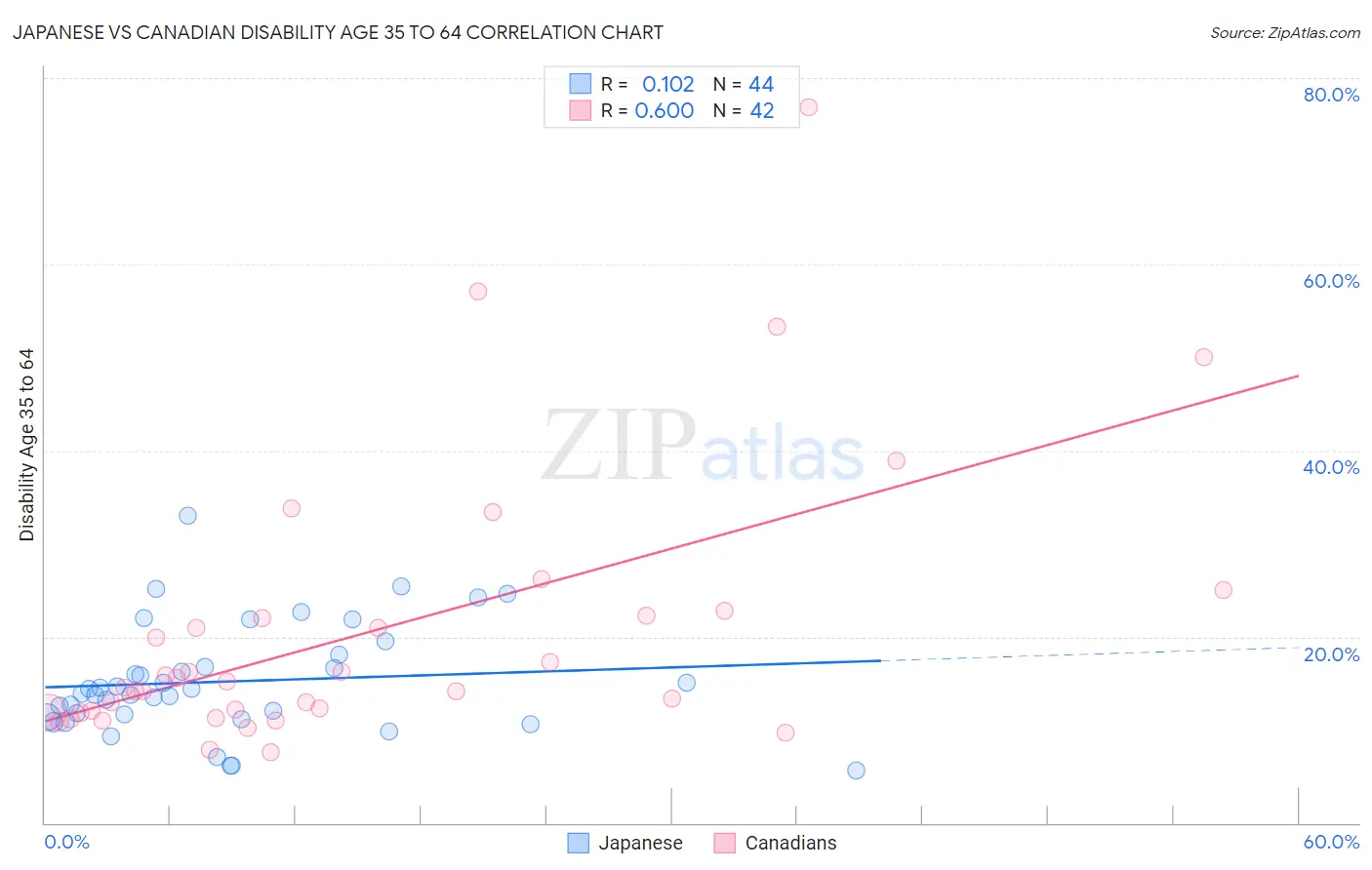Japanese vs Canadian Disability Age 35 to 64
COMPARE
Japanese
Canadian
Disability Age 35 to 64
Disability Age 35 to 64 Comparison
Japanese
Canadians
12.3%
DISABILITY AGE 35 TO 64
0.8/ 100
METRIC RATING
255th/ 347
METRIC RANK
11.7%
DISABILITY AGE 35 TO 64
13.0/ 100
METRIC RATING
211th/ 347
METRIC RANK
Japanese vs Canadian Disability Age 35 to 64 Correlation Chart
The statistical analysis conducted on geographies consisting of 249,049,051 people shows a poor positive correlation between the proportion of Japanese and percentage of population with a disability between the ages 34 and 64 in the United States with a correlation coefficient (R) of 0.102 and weighted average of 12.3%. Similarly, the statistical analysis conducted on geographies consisting of 437,173,623 people shows a significant positive correlation between the proportion of Canadians and percentage of population with a disability between the ages 34 and 64 in the United States with a correlation coefficient (R) of 0.600 and weighted average of 11.7%, a difference of 5.5%.

Disability Age 35 to 64 Correlation Summary
| Measurement | Japanese | Canadian |
| Minimum | 5.7% | 7.6% |
| Maximum | 33.0% | 76.9% |
| Range | 27.4% | 69.3% |
| Mean | 15.2% | 20.6% |
| Median | 14.1% | 14.8% |
| Interquartile 25% (IQ1) | 11.5% | 11.9% |
| Interquartile 75% (IQ3) | 17.4% | 22.3% |
| Interquartile Range (IQR) | 5.9% | 10.4% |
| Standard Deviation (Sample) | 5.8% | 14.8% |
| Standard Deviation (Population) | 5.7% | 14.6% |
Similar Demographics by Disability Age 35 to 64
Demographics Similar to Japanese by Disability Age 35 to 64
In terms of disability age 35 to 64, the demographic groups most similar to Japanese are Hawaiian (12.3%, a difference of 0.13%), Scottish (12.4%, a difference of 0.17%), Dutch (12.3%, a difference of 0.25%), Irish (12.3%, a difference of 0.28%), and Mexican (12.4%, a difference of 0.42%).
| Demographics | Rating | Rank | Disability Age 35 to 64 |
| Spaniards | 1.3 /100 | #248 | Tragic 12.3% |
| Hispanics or Latinos | 1.3 /100 | #249 | Tragic 12.3% |
| Immigrants | Burma/Myanmar | 1.2 /100 | #250 | Tragic 12.3% |
| Germans | 1.1 /100 | #251 | Tragic 12.3% |
| Irish | 1.0 /100 | #252 | Tragic 12.3% |
| Dutch | 1.0 /100 | #253 | Tragic 12.3% |
| Hawaiians | 0.9 /100 | #254 | Tragic 12.3% |
| Japanese | 0.8 /100 | #255 | Tragic 12.3% |
| Scottish | 0.8 /100 | #256 | Tragic 12.4% |
| Mexicans | 0.7 /100 | #257 | Tragic 12.4% |
| Welsh | 0.6 /100 | #258 | Tragic 12.4% |
| English | 0.6 /100 | #259 | Tragic 12.4% |
| German Russians | 0.5 /100 | #260 | Tragic 12.5% |
| Malaysians | 0.5 /100 | #261 | Tragic 12.5% |
| Senegalese | 0.5 /100 | #262 | Tragic 12.5% |
Demographics Similar to Canadians by Disability Age 35 to 64
In terms of disability age 35 to 64, the demographic groups most similar to Canadians are Belgian (11.7%, a difference of 0.010%), European (11.7%, a difference of 0.080%), Immigrants from Jamaica (11.7%, a difference of 0.22%), Yugoslavian (11.7%, a difference of 0.25%), and Guatemalan (11.7%, a difference of 0.27%).
| Demographics | Rating | Rank | Disability Age 35 to 64 |
| Nigerians | 16.3 /100 | #204 | Poor 11.6% |
| Slavs | 15.5 /100 | #205 | Poor 11.7% |
| Native Hawaiians | 14.8 /100 | #206 | Poor 11.7% |
| Ghanaians | 14.8 /100 | #207 | Poor 11.7% |
| Guatemalans | 14.6 /100 | #208 | Poor 11.7% |
| Europeans | 13.5 /100 | #209 | Poor 11.7% |
| Belgians | 13.1 /100 | #210 | Poor 11.7% |
| Canadians | 13.0 /100 | #211 | Poor 11.7% |
| Immigrants | Jamaica | 11.8 /100 | #212 | Poor 11.7% |
| Yugoslavians | 11.6 /100 | #213 | Poor 11.7% |
| Immigrants | Sudan | 11.4 /100 | #214 | Poor 11.7% |
| Spanish American Indians | 11.1 /100 | #215 | Poor 11.7% |
| Bahamians | 10.7 /100 | #216 | Poor 11.8% |
| Barbadians | 9.5 /100 | #217 | Tragic 11.8% |
| Immigrants | Bahamas | 9.2 /100 | #218 | Tragic 11.8% |